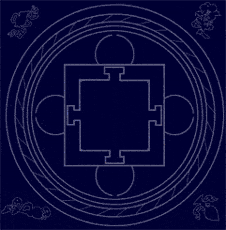Mandala Process :
before drawing , sand applied mandala , after construction,
Background: Initiation, wong-khor, literally means giving permission for the initiator to practice Tantra and to pass on the tantras teachings. The Conductor of the initiation is the ritual master called the Vajra Master. A vajra is an instrument representative of indestructibility. The Vajra Master must pledge to pass on the tantra in a pure form. Objects in the ritual must all be blessed by the Vajra Master like the thepku-house where the mandala is built, the brocade thrown where Vajra Master will sit, and the around the tapestries, scarves, and protective items that are placed around the thrown.
Students ask to be initiated: One of the students in the groups asks the Vajra Master to initiate them. The Vajra Master accepts.
Request Permission from deities: Vajra Master asks spirits for permission to initiate the group. Other monks dance the Dance of Earth to make offerings and gestures through prayers, music and dance to appease the local spirits, and the earth spirit tenma gives him permission from all the other spirits. Next the Vajra Master places daggers around the place where they will build the mandala to protect it. And all the objects used in the construction of the mandala are blessed.
 |
| watch an animation of construction. click to end. |
Initial Outline Drawn:
The Vajra Master makes a blessing and then dips a string in white chalk to begin drawing the lines and it will be used to make the outline of the mandala. This early stage of the mandala drawing takes two days.
On the next day the Vajra Master adds saffron and water to erase certain lines of the mandala, to allow the deities to enter. Then he puts a small grains of sand in particular areas to give them invited cushions to linger on. Next the Vajra Master makes three parallel lines in the center of the mandala to represent the body, speech and mind of the Buddha.
Drawing Process and Completion: Then the monks begin applying the rest of the sand grain by grain through a funnel called a chakpu. When two chakpu are rubbed together, the sand-made from crushed limestone combined with pigment-comes out in a smooth stream. The monks first add sand to the center of the mandala, where the deity will live. They work outwards from the center to map the palace of the deity, and the outer cosmos beyond the palace walls. Each design and color he uses is symbolic. The monks use a special wooden scrapper called a singha to a fix any eras.
After Completion: When the mandala is completed, the monks place vases around it and cover it. They thank the deities through offerings in the form of music, bells, gongs, drums, horns, and a half-hour dance.
Before Initiaton: On the ninth day, the Vajra Master and monks participate in their typical morning prayer and meditations. Afterwards, the students arrive to students pledge to gain new mental patterns that will erase old destructive ones, helping them reach nirvana.
The monks give them kusha grass to put under their pillows at night to help them remember and study in their sleep. The grass symbolizes the Bodhi tree, under which Buddha reached nirvana.
Initiation: Day ten is the initiation. The students enter blindfolded s they will not see the mandala. When the blindfold is taken off, the students awaken from ignorance.
They undergo Seven Childhood Initiations to symbolize their rebirth before they
Receive enlightenment by entering the mandala through the guidance of the Vajra Master.
The Seven Childhood Initiations are a naming, undergoing a first bath, undergoing a first haircut, experiencing the five senses, getting their ear pierced, saying and reading their first words. Next they enter the mandala, “the wheel of time” through the eastern portion of the mandala. They are meant to receive wisdom and compassion, which together will help them achieve enlightenment. The Vajra Master is meant to lead the student’s minds and perception through the mandala.
After the initiation: the monks say a prayer thanking the 722 deities for their participation and they ask them to leave the space of the mandala.
Destuction: Next the Vajra Master cuts the mandala and sweeps the sand, collecting it in an urn. The monks and students, along with the audience will go the river where they will empty the sand into the world, so the deities will protect the world. They return the sand to the earth so that all of the gods’ creatures can gain from the vibrancy and teachings of the mandala.
Conclusion: It is hoped by this process that the students have been reborn, learned to live a life of pure speech, pure body, and pure mind. Buddhism says if you can achieve all three forms of purity, you can reach and inner world of peace and happiness.
see symbolism page to learn how to decode the meaning behind sand mandalas.


